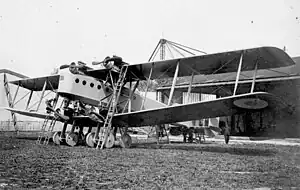| Blériot 71 | |
|---|---|
 | |
| Role | Night bomber |
| National origin | France |
| Manufacturer | Blériot |
| Designer | Touillet |
| First flight | 18 September 1916 |
| Number built | 1 |
The Blériot 71 was a large First World War French heavy night bomber designed and built by Blériot to the BN3 specification. Only a single prototype was built, which was damaged beyond repair on 15 May 1918.[1]
Design and development
The Blériot 71 was a large equal-span biplane with a fuselage braced between the two wings and bearing a strong resemblance to the Blériot 67, (originally designed with the fuselage attached to the lower mainplane).[2] Four 220 hp (164 kW) Hispano-Suiza 8B water-cooled V-8 engines were mounted as close to the centreline as possible, two on the upper wing leading edge and two on the lower wing. The biplane tail unit was originally designed with three fins, but eventually built with just two and the fixed conventional landing gear had four-wheel main units on struts and a tailskid. During flight testing the Bl 71 collided with a Breguet 14 B2 at Villacoublay on 15 May 1918, ending up in a ditch, damaged beyond repair.[1]
Specifications
Data from Aviafrance: Bleriot Bl-71,[2] French aircraft of the First World War[1]
General characteristics
- Crew: 3
- Length: 14 m (45 ft 11 in)
- Wingspan: 26.3 m (86 ft 3 in)
- Height: 6 m (19 ft 8 in)
- Wing area: 140 m2 (1,500 sq ft)
- Empty weight: 3,200 kg (7,055 lb)
- Gross weight: 6,530 kg (14,396 lb)
- Powerplant: 4 × Hispano-Suiza 8B V-8 water-cooled piston engine, 160 kW (220 hp) each
- Propellers: 2-bladed fixed-pitch propellers
Performance
- Maximum speed: 140 km/h (87 mph, 76 kn) at sea level
References
- Notes